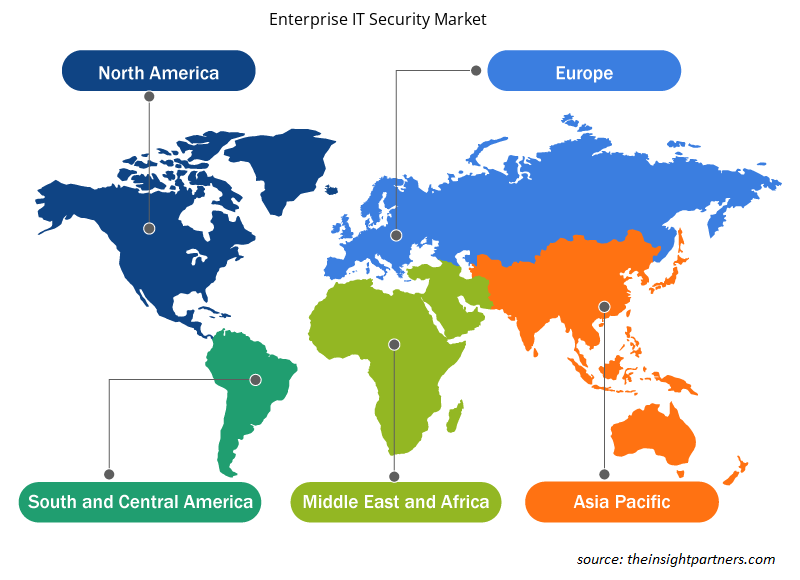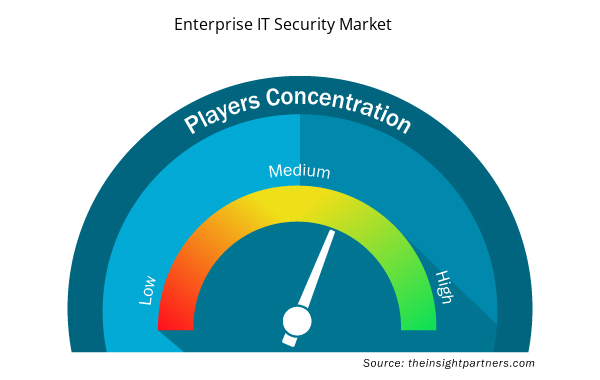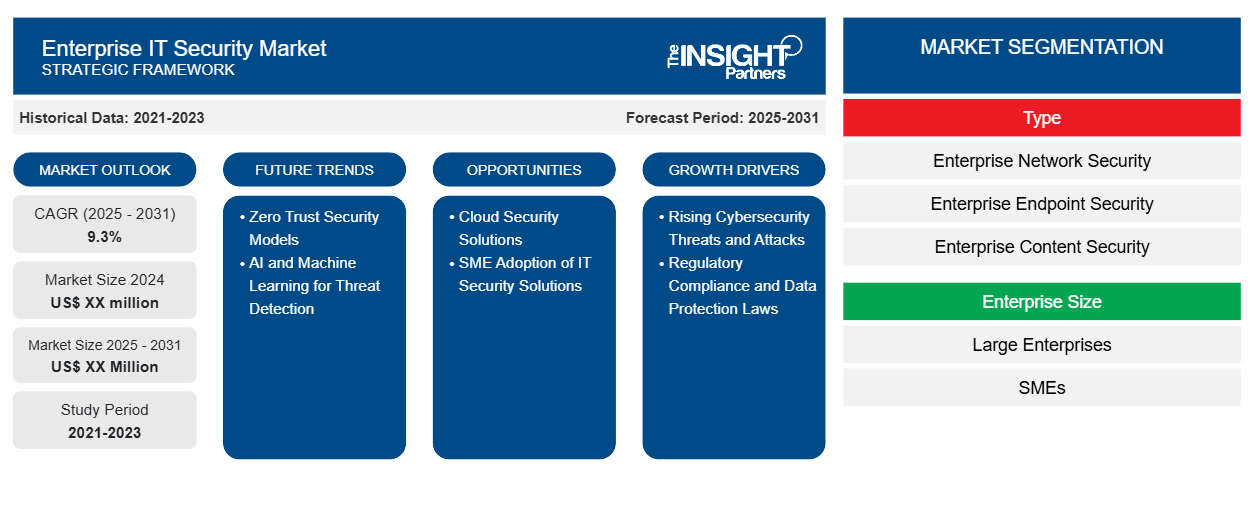Le marché de la sécurité informatique d'entreprise devrait enregistrer un TCAC de 9,3 % de 2023 à 2031, avec une taille de marché passant de XX millions USD en 2023 à XX millions USD d'ici 2031.
Le rapport est segmenté par type (sécurité des réseaux d'entreprise, sécurité des terminaux d'entreprise, sécurité du contenu d'entreprise, cybersécurité d'entreprise, autre) ; taille de l'entreprise (grandes entreprises, PME). L'analyse mondiale est ensuite décomposée au niveau régional et par principaux pays. Le rapport offre la valeur en USD pour l'analyse et les segments ci-dessus.
Objectif du rapport
Le rapport Enterprise IT Security Market de The Insight Partners vise à décrire le paysage actuel et la croissance future, les principaux facteurs moteurs, les défis et les opportunités. Cela fournira des informations à diverses parties prenantes commerciales, telles que :
- Fournisseurs/fabricants de technologie : pour comprendre l’évolution de la dynamique du marché et connaître les opportunités de croissance potentielles, leur permettant de prendre des décisions stratégiques éclairées.
- Investisseurs : Effectuer une analyse complète des tendances concernant le taux de croissance du marché, les projections financières du marché et les opportunités qui existent tout au long de la chaîne de valeur.
- Organismes de réglementation : Réglementer les politiques et surveiller les activités du marché dans le but de minimiser les abus, de préserver la confiance des investisseurs et de maintenir l’intégrité et la stabilité du marché.
Segmentation du marché de la sécurité informatique d'entreprise
Taper
- Sécurité du réseau d'entreprise
- Sécurité des terminaux d'entreprise
- Sécurité du contenu d'entreprise
- Cybersécurité des entreprises
- Autre
Taille de l'entreprise
- Grandes entreprises
- PME
Personnalisez ce rapport en fonction de vos besoins
Vous bénéficierez d'une personnalisation gratuite de n'importe quel rapport, y compris de certaines parties de ce rapport, d'une analyse au niveau des pays, d'un pack de données Excel, ainsi que d'offres et de remises exceptionnelles pour les start-ups et les universités.
- Obtenez les principales tendances clés du marché de ce rapport.Cet échantillon GRATUIT comprendra une analyse de données, allant des tendances du marché aux estimations et prévisions.
Facteurs de croissance du marché de la sécurité informatique d'entreprise
- Augmentation des menaces et des attaques de cybersécurité : la fréquence et la sophistication croissantes des cyberattaques, notamment les ransomwares, le phishing et les violations de données, poussent les entreprises à investir massivement dans la sécurité informatique. Les entreprises ont besoin de solutions de sécurité avancées pour protéger les données sensibles, les réseaux et les applications contre les menaces en constante évolution, ce qui fait de la cybersécurité une priorité absolue pour les budgets informatiques.
- Conformité réglementaire et lois sur la protection des données : avec l'introduction de réglementations strictes en matière de protection des données telles que le RGPD, le CCPA et l'HIPAA, les entreprises sont obligées de mettre en œuvre des mesures de sécurité plus strictes pour éviter les pénalités et protéger la confidentialité des consommateurs. Cette pression réglementaire alimente la demande de solutions de sécurité informatique complètes qui garantissent la conformité et protègent les données sensibles.
Tendances futures du marché de la sécurité informatique des entreprises
- Modèles de sécurité Zero Trust : l'adoption de l'architecture Zero Trust (ZTA) se développe à mesure que les organisations s'éloignent des modèles de sécurité traditionnels basés sur le périmètre. Dans un modèle Zero Trust, aucun utilisateur ou appareil n'est approuvé par défaut, quel que soit son emplacement. Cette approche met l'accent sur la vérification continue, l'authentification forte et l'accès au moindre privilège, ce qui stimule la demande de solutions avancées de gestion des identités et des accès (IAM).
- IA et apprentissage automatique pour la détection des menaces : l’IA et l’apprentissage automatique sont intégrés aux solutions de sécurité informatique pour améliorer la détection des menaces, l’identification des anomalies et la réponse automatisée. Ces technologies permettent aux systèmes de sécurité d’analyser de grands volumes de données, de reconnaître des modèles et de prédire les vulnérabilités potentielles, améliorant ainsi la posture de sécurité globale et réduisant les temps de réponse aux menaces émergentes.
Opportunités du marché de la sécurité informatique d'entreprise
- Solutions de sécurité cloud : les entreprises transfèrent de plus en plus leurs opérations vers des plateformes basées sur le cloud, ce qui accroît le besoin de solutions de sécurité cloud robustes. La sécurité cloud englobe un large éventail de solutions, notamment la gestion des identités et des accès (IAM), le chiffrement, la sécurité des applications cloud et la détection des menaces. Les fournisseurs de services cloud et les fournisseurs de sécurité tiers développent en permanence de nouveaux outils pour répondre aux défis de sécurité associés aux environnements cloud. Alors que l'adoption du cloud continue de croître, en particulier dans des secteurs tels que la santé, la finance et la vente au détail, le segment de la sécurité cloud présente une opportunité de croissance significative.
- Adoption des solutions de sécurité informatique par les PME : Alors que les grandes entreprises ont depuis longtemps adopté des solutions de sécurité informatique, les petites et moyennes entreprises (PME) reconnaissent désormais de plus en plus l’importance de la cybersécurité. De nombreuses PME sont vulnérables aux cyberattaques en raison de ressources limitées et d’un manque de sensibilisation. Les fournisseurs de sécurité développent des solutions rentables et évolutives adaptées aux besoins des PME. Cette demande croissante de cybersécurité parmi les petites entreprises crée un potentiel de croissance important dans ce segment.
Informations régionales sur le marché de la sécurité informatique des entreprises
Les tendances et facteurs régionaux influençant le marché de la sécurité informatique d’entreprise tout au long de la période de prévision ont été expliqués en détail par les analystes d’Insight Partners. Cette section traite également des segments et de la géographie du marché de la sécurité informatique d’entreprise en Amérique du Nord, en Europe, en Asie-Pacifique, au Moyen-Orient et en Afrique, ainsi qu’en Amérique du Sud et en Amérique centrale.

- Obtenez les données régionales spécifiques au marché de la sécurité informatique des entreprises
Portée du rapport sur le marché de la sécurité informatique des entreprises
| Attribut de rapport | Détails |
|---|---|
| Taille du marché en 2023 | XX millions de dollars américains |
| Taille du marché d'ici 2031 | XX millions de dollars américains |
| Taux de croissance annuel composé mondial (2023-2031) | 9,3% |
| Données historiques | 2021-2022 |
| Période de prévision | 2024-2031 |
| Segments couverts | Par type
|
| Régions et pays couverts | Amérique du Nord
|
| Leaders du marché et profils d'entreprises clés |
|
Densité des acteurs du marché de la sécurité informatique d'entreprise : comprendre son impact sur la dynamique des entreprises
Le marché de la sécurité informatique d'entreprise connaît une croissance rapide, tirée par la demande croissante des utilisateurs finaux en raison de facteurs tels que l'évolution des préférences des consommateurs, les avancées technologiques et une plus grande sensibilisation aux avantages du produit. À mesure que la demande augmente, les entreprises élargissent leurs offres, innovent pour répondre aux besoins des consommateurs et capitalisent sur les tendances émergentes, ce qui alimente davantage la croissance du marché.
La densité des acteurs du marché fait référence à la répartition des entreprises ou des sociétés opérant sur un marché ou un secteur particulier. Elle indique le nombre de concurrents (acteurs du marché) présents sur un marché donné par rapport à sa taille ou à sa valeur marchande totale.
Les principales entreprises opérant sur le marché de la sécurité informatique d'entreprise sont :
- Avast Software s.r.l.
- Technologies logicielles Check Point Ltd
- Cisco Systems, Inc.
- Systèmes Citrix, Inc.
- Dell Inc.
Avis de non-responsabilité : les sociétés répertoriées ci-dessus ne sont pas classées dans un ordre particulier.

- Obtenez un aperçu des principaux acteurs du marché de la sécurité informatique d'entreprise
Principaux arguments de vente
- Couverture complète : Le rapport couvre de manière exhaustive l’analyse des produits, des services, des types et des utilisateurs finaux du marché de la sécurité informatique d’entreprise, offrant un paysage holistique.
- Analyse d’experts : Le rapport est compilé sur la base d’une compréhension approfondie des experts et analystes du secteur.
- Informations à jour : Le rapport garantit la pertinence commerciale en raison de sa couverture des informations récentes et des tendances des données.
- Options de personnalisation : ce rapport peut être personnalisé pour répondre aux exigences spécifiques du client et s'adapter parfaitement aux stratégies commerciales.
Le rapport de recherche sur le marché de la sécurité informatique d’entreprise peut donc aider à ouvrir la voie au décodage et à la compréhension du scénario de l’industrie et des perspectives de croissance. Bien qu’il puisse y avoir quelques préoccupations valables, les avantages globaux de ce rapport ont tendance à l’emporter sur les inconvénients.
- Analyse historique (2 ans), année de base, prévision (7 ans) avec TCAC
- Analyse PEST et SWO
- Taille du marché Valeur / Volume - Mondial, Régional, Pays
- Industrie et paysage concurrentiel
- Ensemble de données Excel


- Visualization and 3D Rendering Software Market
- Green Hydrogen Market
- Playout Solutions Market
- Vessel Monitoring System Market
- Electronic Health Record Market
- Airline Ancillary Services Market
- Animal Genetics Market
- Organoids Market
- Emergency Department Information System (EDIS) Market
- Hair Extensions Market

Report Coverage
Revenue forecast, Company Analysis, Industry landscape, Growth factors, and Trends

Segment Covered
This text is related
to segments covered.

Regional Scope
North America, Europe, Asia Pacific, Middle East & Africa, South & Central America

Country Scope
This text is related
to country scope.
Questions fréquemment posées
Some of the customization options available based on the request are an additional 3-5 company profiles and country-specific analysis of 3-5 countries of your choice. Customizations are to be requested/discussed before making final order confirmation# as our team would review the same and check the feasibility
AI and Machine Learning for Threat Detection is likely to remain a key trend in the market.
Key players in the enterprise IT security market include Avast Software, Check Point Software Technologies Ltd, Cisco Systems, Inc, Citrix Systems, Inc., Dell Inc., Fortinet, Inc., F-Secure, Hewlett Packard Enterprise Development LP, IBM, and Sophos Ltd.
The major factors driving the enterprise IT security market are:
1. Rising Cybersecurity Threats and Attacks.
2.Regulatory Compliance and Data Protection Laws
The Enterprise IT Security Market is estimated to witness a CAGR of 9.3% from 2023 to 2031
Trends and growth analysis reports related to Technology, Media and Telecommunications : READ MORE..
The List of Companies
- Avast Software s.r.o.
- Check Point Software Technologies Ltd
- Cisco Systems, Inc.
- Citrix Systems, Inc.
- Dell Inc.
- Fortinet, Inc.
- F-Secure
- Hewlett Packard Enterprise Development LP
- IBM
- Sophos Ltd.
The Insight Partners performs research in 4 major stages: Data Collection & Secondary Research, Primary Research, Data Analysis and Data Triangulation & Final Review.
- Data Collection and Secondary Research:
As a market research and consulting firm operating from a decade, we have published and advised several client across the globe. First step for any study will start with an assessment of currently available data and insights from existing reports. Further, historical and current market information is collected from Investor Presentations, Annual Reports, SEC Filings, etc., and other information related to company’s performance and market positioning are gathered from Paid Databases (Factiva, Hoovers, and Reuters) and various other publications available in public domain.
Several associations trade associates, technical forums, institutes, societies and organization are accessed to gain technical as well as market related insights through their publications such as research papers, blogs and press releases related to the studies are referred to get cues about the market. Further, white papers, journals, magazines, and other news articles published in last 3 years are scrutinized and analyzed to understand the current market trends.
- Primary Research:
The primarily interview analysis comprise of data obtained from industry participants interview and answers to survey questions gathered by in-house primary team.
For primary research, interviews are conducted with industry experts/CEOs/Marketing Managers/VPs/Subject Matter Experts from both demand and supply side to get a 360-degree view of the market. The primary team conducts several interviews based on the complexity of the markets to understand the various market trends and dynamics which makes research more credible and precise.
A typical research interview fulfils the following functions:
- Provides first-hand information on the market size, market trends, growth trends, competitive landscape, and outlook
- Validates and strengthens in-house secondary research findings
- Develops the analysis team’s expertise and market understanding
Primary research involves email interactions and telephone interviews for each market, category, segment, and sub-segment across geographies. The participants who typically take part in such a process include, but are not limited to:
- Industry participants: VPs, business development managers, market intelligence managers and national sales managers
- Outside experts: Valuation experts, research analysts and key opinion leaders specializing in the electronics and semiconductor industry.
Below is the breakup of our primary respondents by company, designation, and region:

Once we receive the confirmation from primary research sources or primary respondents, we finalize the base year market estimation and forecast the data as per the macroeconomic and microeconomic factors assessed during data collection.
- Data Analysis:
Once data is validated through both secondary as well as primary respondents, we finalize the market estimations by hypothesis formulation and factor analysis at regional and country level.
- Macro-Economic Factor Analysis:
We analyse macroeconomic indicators such the gross domestic product (GDP), increase in the demand for goods and services across industries, technological advancement, regional economic growth, governmental policies, the influence of COVID-19, PEST analysis, and other aspects. This analysis aids in setting benchmarks for various nations/regions and approximating market splits. Additionally, the general trend of the aforementioned components aid in determining the market's development possibilities.
- Country Level Data:
Various factors that are especially aligned to the country are taken into account to determine the market size for a certain area and country, including the presence of vendors, such as headquarters and offices, the country's GDP, demand patterns, and industry growth. To comprehend the market dynamics for the nation, a number of growth variables, inhibitors, application areas, and current market trends are researched. The aforementioned elements aid in determining the country's overall market's growth potential.
- Company Profile:
The “Table of Contents” is formulated by listing and analyzing more than 25 - 30 companies operating in the market ecosystem across geographies. However, we profile only 10 companies as a standard practice in our syndicate reports. These 10 companies comprise leading, emerging, and regional players. Nonetheless, our analysis is not restricted to the 10 listed companies, we also analyze other companies present in the market to develop a holistic view and understand the prevailing trends. The “Company Profiles” section in the report covers key facts, business description, products & services, financial information, SWOT analysis, and key developments. The financial information presented is extracted from the annual reports and official documents of the publicly listed companies. Upon collecting the information for the sections of respective companies, we verify them via various primary sources and then compile the data in respective company profiles. The company level information helps us in deriving the base number as well as in forecasting the market size.
- Developing Base Number:
Aggregation of sales statistics (2020-2022) and macro-economic factor, and other secondary and primary research insights are utilized to arrive at base number and related market shares for 2022. The data gaps are identified in this step and relevant market data is analyzed, collected from paid primary interviews or databases. On finalizing the base year market size, forecasts are developed on the basis of macro-economic, industry and market growth factors and company level analysis.
- Data Triangulation and Final Review:
The market findings and base year market size calculations are validated from supply as well as demand side. Demand side validations are based on macro-economic factor analysis and benchmarks for respective regions and countries. In case of supply side validations, revenues of major companies are estimated (in case not available) based on industry benchmark, approximate number of employees, product portfolio, and primary interviews revenues are gathered. Further revenue from target product/service segment is assessed to avoid overshooting of market statistics. In case of heavy deviations between supply and demand side values, all thes steps are repeated to achieve synchronization.
We follow an iterative model, wherein we share our research findings with Subject Matter Experts (SME’s) and Key Opinion Leaders (KOLs) until consensus view of the market is not formulated – this model negates any drastic deviation in the opinions of experts. Only validated and universally acceptable research findings are quoted in our reports.
We have important check points that we use to validate our research findings – which we call – data triangulation, where we validate the information, we generate from secondary sources with primary interviews and then we re-validate with our internal data bases and Subject matter experts. This comprehensive model enables us to deliver high quality, reliable data in shortest possible time.


 Obtenez un échantillon gratuit pour ce rapport
Obtenez un échantillon gratuit pour ce rapport